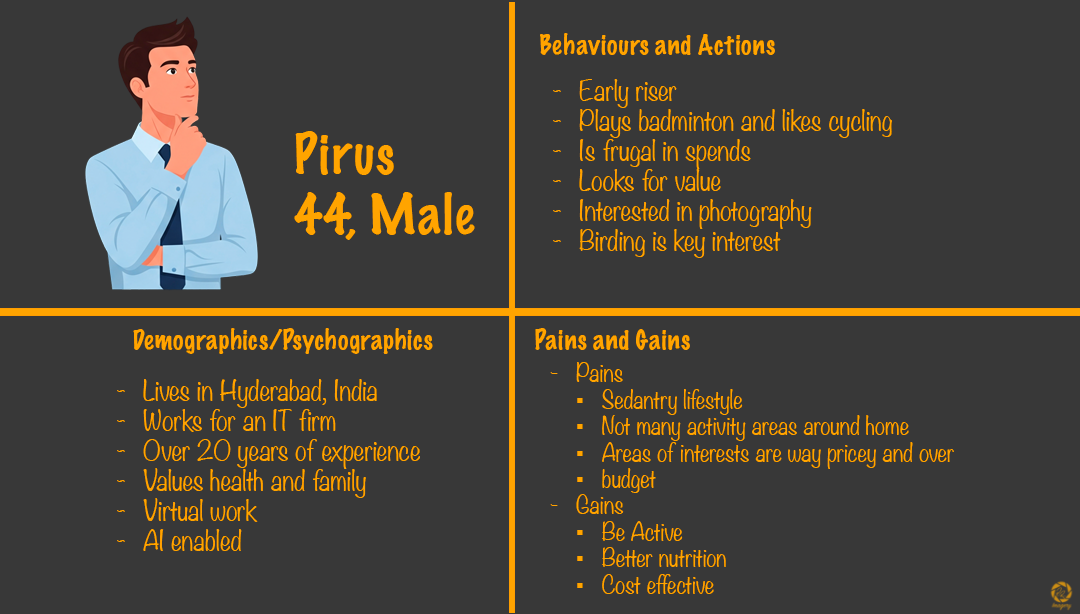In order to create valuable and useful products, it is necessary for the Product Owner to understand the needs and expectations of the customer. However, it is not always possible to have direct access to the end user. And that could create some challenges. In scenarios, where the Product Owner does not have a direct access to the end customer, they will have to rely on other approaches to build an hypothesis of the needs and expectations of the customer.
In this article I explore one such approach - Personas.
What are Personas?
Persona can be considered as a hypothesis about the end user. It is a fictional/semi fictional character that depicts the target audience for the product. A persona can be created based on multiple inputs. It might be based on a thorough user research or interviews and analytics; especially if the product is already in the market. While at other times it could be best hypothesis of a possible target audience. Having a persona often converts raw, abstract data into a character that one can relate with.

Why do we need a Persona?
Personas are a great tool for the Product Owner. It enables the Product Owner to:
Create Alignment:
Having a persona, allows the Product Owner to establish key characteristics of their target audience. This helps the PO to create alignment with stakeholders, developers and anyone else involved in the product development about what the end user needs instead of just making a guess for the target audience.
Build Empathy:
Having a persona in place, the PO can focus on the pains/gains or the needs and expectations of the target audience. This allows them to get into the shoes of the customer and let go of personal biases or perspectives.
Improve Decision Making:
Having a clarity of what customer problems we plan to solve; what customers needs/expectations we want to address; enables the Product Owners to make decisions for ordering, prioritization, design and even marketing.
What to consider when creating a persona?
When creating a persona there are few aspects that become crucial for understanding the target audience. This information includes but is not limited to:
- Name and Photo: To make the persona memorable and human.
- Demographics: Relevant details like age, job title, location, and family status.
- Psychographic and Ethnographic Details: Information like the Values, Social Status, Personality, Opinions and Interests.
- Goals & Motivations: What is this person trying to achieve? What drives them? This is often the most critical component.
- Pain Points: What obstacles or challenges do they face in trying to achieve their goals?
- Gains & Benefits: What are the key benefits they are looking for? What is the underserved need or desire?
- Behaviors & Habits: How do they work? What does their typical day look like? What tools or technology do they use?
- A Quote or Motto: A short, powerful sentence that summarizes their attitude or primary motivation for ex: ‘Action over Thought’.
Types of personas:
Based on what the Product Owner wants to achieve or the information the Product Owner wants to infer, Personas can be divided into a few categories. The most common personas that I have come across include:
- User Persona
- Buyer Persona
- Customer Persona
- Marketing Persona
- Proto Persona
User Persona
A User Persona focuses on the behavioral aspects of how someone interacts with the product or service. This persona focuses on understanding the user's needs, their current pain points, and the context in which they'll use the product.
Buyer Persona
A Buyer Persona is centered on the purchasing process. It represents the individual who makes the decision to buy the product. This is often helpful in the scenarios where the person who pays for the product is different from the person who uses the product.
Customer Persona
A Customer Persona usually represents an ideal, existing customer. This persona focuses on the overall relationship of the target customer with the product instead of focusing on a single action like buying or using.
Marketing Persona
A Marketing Persona is focused on how to reach and communicate with the target audience. This persona is shaped by how to reach the customer. Focuses on the channels, messaging to reach the customer. Helps the Product Owner to guide the content and strategy for marketing.
Proto Persona
A Proto Persona is a persona that is more fictional, based on approximate guesses. A proto persona is created using the existing knowledge and assumptions about who the users are. This is often the starting point when PO is pressed against time and budget for initial research.
To Conclude:
Amongst the plethora of tools available for User Research, Personas are the simplest and easiest to start. It helps you profile your target audience and address their most important needs or biggest pain points.
With the availability of AI tools, it has become even easier for Product Owners to brainstorm on Personas with a very little effort. One good prompt and you get a well crafted persona ready within a minute.
P.S. If you are interested, I have crafted some prompts based on various domains that I have worked in the past. Comment and let me know and I can share that with you.
P.P.S. If interested to learn more about such tools and techniques explore the Product Owner workshops at https://agilemania.com/professional-scrum-product-owner-pspo-training
